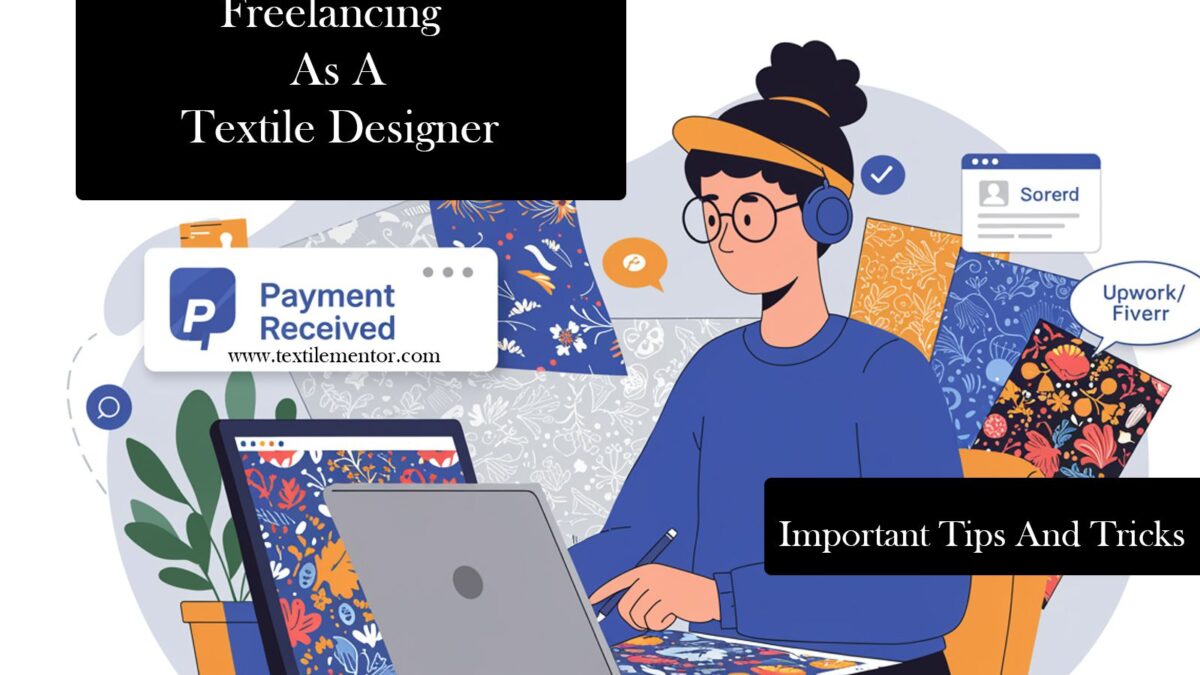Freelancing as a Textile Designer: Tips for Building a Successful Career

Jacquard Textile Design: Dive into the Art of Woven Patterns
May 22, 2025Freelancing as a Textile Designer: Tips for Building a Successful Career
Welcome to the vibrant world of textile design, where creativity intertwines with commerce! As a freelance textile designer, you possess the unique ability to transform fabrics into art and ideas into wearable statements. But amid this colorful canvas lies a challenge—how do you effectively market yourself in an industry brimming with talent? Whether you’re just starting or looking to elevate your brand, mastering the art of self-promotion is crucial. In this blog post, we’ll unravel essential strategies that will help you showcase your creative flair, connect with potential clients, and stand out in a competitive marketplace. Get ready to weave your personal brand and attract opportunities that bring your designs to life!
Introduction to Freelancing as a Textile Designer
Are you passionate about patterns and colors? Do you dream of transforming your creativity into a freelance career? If so, freelancing as a textile designer might be the perfect path for you. The textile industry is vibrant and full of opportunities for talented individuals who want to showcase their unique designs.
This guide will walk you through everything you need to know to successfully market yourself as a freelance textile designer. From understanding the difficulties of the industry to building your personal brand, we’ve got all bases covered. Whether you’re just starting or looking to refine your approach, you’ll find valuable insights that can help elevate your freelancing journey in textile design.
Understanding the Textile Design Industry
The textile design industry is a vibrant blend of creativity and innovation. Designers craft beautiful fabrics that can transform everything from fashion to interior décor. Understanding this world requires awareness of trends, techniques, and materials.
Market demand shifts constantly, influenced by cultural movements and technological advancements. Sustainability has emerged as a crucial consideration for many designers today. Eco-friendly practices are no longer optional but often essential to appeal to conscious consumers.
Read Also: Entrepreneurship in Textile Industry: Scope and Opportunities
Collaboration plays a significant role in the industry. Textile designers frequently work with fashion houses, furniture brands, or even artists to create unique pieces. Networking within these circles opens doors to exciting projects.
Additionally, technical skills like CAD software proficiency are becoming increasingly important. Mastering these tools allows designers to visualize their concepts more effectively while also streamlining production processes.
Staying informed about industry changes will help you carve out your niche in freelancing as a textile designer
Building Your Brand as a Freelance Textile Designer
Building your brand as a freelance textile designer begins with creating a striking portfolio. Showcase your best work, and be sure to include various styles and techniques. Next, establishing an online presence is crucial. A well-designed website can serve as your digital storefront. Include an engaging “About” section that tells your story and highlights your unique approach to design. Don’t underestimate the power of networking. Engage with other designers through social media or local events. Collaborating on projects not only expands your skill set but also introduces you to new audiences. Lastly, consistency in branding is key across all platforms—from social media profiles to business cards—everything should reflect who you are as a designer, making it easier for potential clients to recognize and remember you.

Creating a Portfolio:
A strong portfolio is essential for freelancing as a textile designer. It showcases your skills and unique style to potential clients. Start by curating your best work, focusing on projects that highlight your versatility and creativity.
Include a mix of designs: printed fabrics, patterns, and illustrations. This variety demonstrates your range and ability to adapt to different styles or trends. High-quality images are crucial—invest time in capturing or editing them for clarity.
Consider adding project descriptions. Briefly outline the concept behind each piece, materials used, and any challenges you overcame during the design process. This provides insight into your creative journey.
Lastly, If you want to do freelancing as a textile designer keep it up-to-date with new projects as you grow professionally. An evolving portfolio reflects your commitment to improvement and innovation in textile design.
Establishing an Online Presence:
Establishing an online presence is crucial for any freelance textile designer. Your digital footprint can significantly influence your visibility and credibility in the market.
Start by creating a professional website showcasing your portfolio. Include high-quality images of your work and detailed descriptions to engage potential clients. A blog section on design trends or personal projects can add depth to your site.
Social media platforms are powerful tools too. Use Instagram, Pinterest, and LinkedIn to share snippets of your designs and connect with others in the industry. Regular updates keep your audience engaged while showcasing your creativity.
Don’t forget about SEO strategies when setting up your online profiles. Utilize keywords relevant to freelancing as a textile designer throughout your content for better search engine rankings.

Engaging with followers through comments and direct messages builds relationships that could lead to future collaborations or commissions.
Networking and Collaborating with Other Designers
In freelancing as a textile designer .Networking with other designers can open doors to new opportunities and ideas. Building relationships in the textile design community fosters collaboration, leading to innovative projects that reflect diverse perspectives.
Attend workshops, join online forums, or participate in design challenges. These environments are perfect for meeting like-minded individuals who share your passion. Don’t hesitate to reach out on social media; a simple message can spark an exciting partnership.
Read Also: Career in Textile: Jobs and Opportunities In Textile Industry
In freelancing as a textile designer collaboration isn’t just beneficial for gaining visibility; it’s also about learning from one another. Each designer brings unique skills and insights that can enhance your work. Consider co-hosting events or creating joint collections—these ventures not only expand your portfolio but also introduce you to different audiences.
Remember, every connection counts. Whether it’s a casual coffee chat or a formal collaboration, nurturing these relationships is key to thriving as a freelance textile designer.
Marketing Strategies for Freelance Textile Designers
Marketing yourself as a freelance textile designer requires creativity and strategy. Start by identifying your target market. Understand who will benefit from your designs—be it fashion brands, home décor companies, or independent artisans. Tailor your approach accordingly. Utilizing social media is essential for visibility. Platforms like Instagram and Pinterest thrive on visual content, making them perfect for showcasing your work. Engage with followers through behind-the-scenes looks at your creative process. Don’t underestimate the power of networking events and trade shows. These gatherings provide opportunities to meet potential clients and collaborators face-to-face. Bring business cards to make lasting connections.
In freelancing as a textile designer Consider creating informative blog posts or tutorials about textile design techniques. This not only positions you as an authority in the field but also attracts visitors who may need design services in the future. Each piece contributes to building a strong personal brand that resonates with potential clients.
Identifying Your Target Market:
- Identifying your target market is crucial for freelancing as a textile designer. Understanding who will buy your designs helps tailor your approach.
- Start by researching different sectors within the industry. Fashion, home decor, and upholstery are just a few areas where your work might fit. Each sector has its own audience with unique preferences.
- Next, analyze existing customers or clients you’ve had in the past. What types of businesses were they? This can provide insights into similar markets that may be interested in your textiles.
- Don’t forget to explore niche markets too. Sustainable fashion or handmade goods are growing trends that could boost visibility and sales for designers willing to innovate within those spaces.

Utilizing Social Media and Online Platforms:
Social media is a game changer for freelancing as a textile designer . It offers an unparalleled platform to showcase your work and connect with potential clients.
- Instagram and Pinterest are particularly effective for visual storytelling. Share images of your designs, behind-the-scenes processes, and even inspiration boards. Use relevant hashtags to reach a broader audience interested in textile design.
- Don’t underestimate the power of LinkedIn either. This professional network allows you to highlight your skills, share articles about industry trends, and engage with other professionals in the field.
- Consider joining Facebook groups dedicated to textile design or freelancing. These communities can provide valuable insights while also serving as networking opportunities.
- Lastly, platforms like Behance or Dribble enable you to create stunning portfolios that attract attention from brands looking for fresh talent. Engage actively on these sites by commenting on others’ work—it builds connections that could lead to collaborations down the line.
Networking Events and Trade Shows:
Attending networking events and trade shows can be a game-changer for freelance textile designers. These gatherings offer invaluable opportunities to connect with industry professionals, potential clients, and fellow creatives.
- When you step into a vibrant trade show, you’ll find inspiration around every corner. From the latest fabric innovations to stunning design showcases, immersing yourself in this environment fuels your creativity.
- For freelancing as a textile designer engaging in conversations at these events helps build relationships that may lead to collaborations or job referrals down the line. Carry business cards or digital portfolios handy; you never know when an opportunity might arise.
- Don’t shy away from participating in workshops or panel discussions either. Sharing your insights can position you as an expert while expanding your network even further.
- Remember, follow up after these events. A simple message expressing gratitude for their time fosters connection and keeps the conversation going long after the event ends.
Negotiating Rates and Contracts as a Freelance Textile Designer
Negotiating rates and contracts can feel daunting, but it’s crucial for your success as a freelance textile designer. Start by researching industry standards to understand what others are charging.
When discussing rates with clients, be clear about the value you bring. Highlight your unique skills and previous work to justify your pricing. Don’t hesitate to ask questions about their budget; this dialogue can lead to a mutually beneficial agreement.
Read Also: Textile Engineering: Growing Importance and scope
Contracts should outline deliverables, timelines, and payment terms in detail. This clarity helps prevent misunderstandings later on. Always read through agreements carefully before signing.
Stay flexible during negotiations but know your worth. If clients push back on pricing, consider offering tiered options or additional services that enhance the project without compromising your value.
Being prepared will give you confidence when discussing contracts—an essential part of freelancing as a textile designer.
Managing Clients and Projects Successfully
Managing clients and projects as a freelance textile designer requires strong communication skills. Clear dialogue helps set expectations from the start. Make sure to discuss project details, timelines, and any specific requirements.
Time management is equally critical. Create a schedule that outlines milestones for each project phase. This way, you can avoid last-minute rushes while ensuring timely delivery. Setting boundaries is vital in maintaining professional relationships. Let clients know your availability upfront to prevent misunderstandings later on. Effective feedback loops enhance collaboration too. Regular check-ins allow you to address concerns early on and make necessary adjustments without derailing progress.
Lastly, be adaptable but firm when negotiating changes or additional requests; this protects both your time and creative energy while keeping clients satisfied with the final product.
Communication and Time Management Skills:
Effective communication is vital for freelance textile designers. Clear dialogue with clients ensures that everyone shares the same vision. Asking questions and seeking feedback helps to refine ideas.
Time management also plays a crucial role in balancing multiple projects. Prioritizing tasks can prevent last-minute rushes and reduce stress levels. Utilize tools like calendars or project management apps to keep track of deadlines.
Establishing regular check-ins with clients fosters trust and transparency. It keeps projects on course while addressing any concerns promptly.
Setting realistic timelines not only enhances productivity but also allows for creative exploration without pressure. This balance is essential for maintaining quality, which is key in the competitive textile industry.
Setting Boundaries and Managing Expectations:
Setting boundaries is crucial for any freelance textile designer. It helps you maintain your creative energy while ensuring that clients understand your limits.
For a freelancing as a textile designer Decide on your working hours early on and communicate them clearly. This practice not only protects your personal time but also sets a professional tone in client relationships.
Managing expectations goes hand-in-hand with boundaries. Be upfront about timelines, project scope, and deliverables. This transparency reduces the likelihood of misunderstandings later. Encourage open dialogue so clients feel comfortable sharing their thoughts without overwhelming you.
Remember to prioritize self-care too. Taking breaks will enhance creativity and productivity, leading to better outcomes for both you and your clients.
Tips for Maintaining a Successful Freelance Career in Textile Design
- Staying organized is key. Use project management tools to keep track of deadlines and client expectations. This will help you maintain a steady workflow.
- Regularly update your portfolio with fresh work. Showcase new designs that reflect your evolving style and skills. An engaging portfolio attracts potential clients.
- Set specific working hours. It’s easy to blur the lines between personal time and professional obligations when freelancing. Clear boundaries improve productivity.
- Continue learning about design trends and techniques. Attend online courses or workshops to enhance your craft. Staying current keeps you competitive in the market.
- Seek feedback from peers and clients alike. Constructive criticism can provide insights that strengthen your work, leading to better results over time.
- Lastly, cultivate resilience in facing rejection or challenges in this industry. Each setback offers an opportunity for growth, paving the way for future success in textile design.
Conclusion
Freelancing as a textile designer can be both exhilarating and challenging. The freedom to express your creativity while managing your own business is appealing. However, it requires strategic planning and execution to thrive in the industry.
As you embark on this journey, remember that building a strong brand starts with creating an impressive portfolio. Showcase your unique style and skills effectively to attract potential clients. Your online presence is equally crucial; maintain active profiles on design platforms and social media channels where you can showcase your work.
For freelancing as a textile designer networking plays a vital role in gaining visibility within the textile community. Collaborate with other designers or participate in local art events to expand your reach.
Marketing strategies vary widely based on who you want to target—be sure to identify your niche market early on. Use social media not just for promotion but also for engaging with followers who appreciate innovative designs.
Negotiating rates can feel daunting at first, but understanding the value of your work will empower you during discussions with clients. Clearly outline project terms through contracts that protect both parties involved.
Managing projects calls for strong communication skills along with effective time management practices. Setting boundaries helps ensure that expectations are understood from the get-go, making collaborations smoother.
Maintaining success as a freelance textile designer relies heavily on adaptability and continuous learning within this evolving field. Embrace new trends, experiment without fear, and stay connected with peers who inspire growth alongside you in this vibrant career path.










